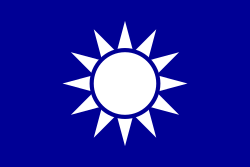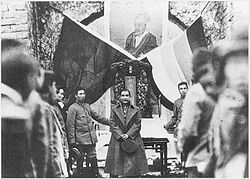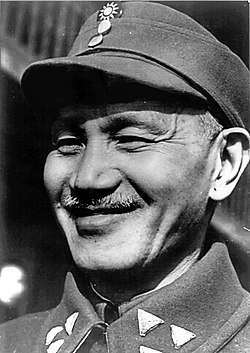This article has multiple issues. Please help improve it or discuss these issues on the talk page. (Learn how and when to remove these messages)
|
| Han nationalism | |||||||||
|---|---|---|---|---|---|---|---|---|---|
| Traditional Chinese | 漢民族主義 | ||||||||
| Simplified Chinese | 汉民族主义 | ||||||||
| |||||||||


Han nationalism is a form of ethnic nationalism asserting ethnically Han Chinese as the exclusive constituents of the Chinese nation. It is often in dialogue with other conceptions of Chinese nationalism, often mutually-exclusive or otherwise contradictory ones. Han Chinese are the dominant ethnic group in both states claiming to represent the Chinese nation: the Republic of China and the People's Republic of China.
Han Chinese also constitute a sizable ethnic minority or plurality group in a number of other countries, such as Malaysia and Singapore. In the modern era, ethnicity's role in the Chinese nation continue to color conceptions of Chinese culture, geopolitics, and history.
History
[edit]
Unlike Chinese nationalism, Han Chinese nationalism has a historical root of being strongly stressed on the Han Chinese people, the dominant ethnic group of China that originates from Huaxia or Sinitic people. Han Chinese nationalism has often been used as a rallying force, stemming from the historical pride of the Han Chinese people in developing one of the world's earliest civilizations.[1][2]
Since the Han dynasty, ideas of Han Chinese superiority have been frequently used in attempts to expand China's territory. Examples of this can be seen in previous Chinese invasions of Korea and Vietnam, and in historical conquests of Central Asia, Tibet, Xinjiang and Mongolia.[3][4][5] This was later inherited by later dynasties of China, notably the Tang dynasty and the Ming dynasty. The Tang dynasty exerted control beyond the border of old Huaxia, allowing the later Ming dynasty to become a major naval power. Han Chinese ideas of superiority were complex, with contrasting Confucian narratives of Han superiority and ones of diversity in the army and the Empire.[6][7][8][9]
Han Chinese nationalism also played a key part in rallying against non-Han control of China. The Han Chinese nationalist movement led by Ming dynasty's Hongwu Emperor played an instrumental role in the overthrow of the Mongol Yuan dynasty.[10] Han Chinese nationalism was also integral to the rebellion against the Manchu Qing dynasty and became increasingly institutionalized following the Century of Humiliation. These rebellions were often led by Han Chinese nationalists, including Sun Yat-sen, who considered the Manchu Qing dynasty corrupt and immoral, and took an aggressive stance against Western imperialism.[11][12][13] The Boxer Rebellion in late 19th century had been seen as another specific part of Han Chinese nationalism juxtaposed against Western imperialism in China, where Han Chinese nationalists were against Western and modern ideas and sought to revive old Chinese traditions.[14][15]
Following the fall of the Qing dynasty, Sun Yat-sen attempted to build a more multi-ethnic form of Chinese nationalism. He had some noteworthy successes, such as the rise of Nationalist China and the five-colored flag. Han Chinese nationalism remains prominent in China today. Chinese leaders have employed Han nationalist sentiments, including the ongoing Han domination of China, and promotion of nationalism, as witnessed in the Republic's domestic and foreign relations.[16]
Han chauvinism
[edit]Han chauvinism is described as a more radical form of Han nationalism by the Chinese Communist Party (CCP). The CCP chairman Mao Zedong coined the term in order to describe the chauvinism of the Han Chinese, first on 16 March 1953, in order to criticize the ethnocentrism that existed among the Han Chinese in China. In a party directive which was drafted for the Central Committee of the Chinese Communist Party titled "Criticize Han Chauvinism," Mao said, "In some places, the relations between nationalities are far from normal. For Communists, this is an intolerable situation. We must go to the root and criticize the Han chauvinist ideas which exist to a serious degree among many Party members and cadres ..."[17]
It appeared again in a 1956 speech, titled Ten Major Relations, Mao stated that "on the relationship between the Han ethnicity and minority ethnicities ... we put the emphasis on opposing Han chauvinism".[18] This anti-chauvinistic idea is part of the People's Republic of China's zhonghua minzu conception of China as a multi-ethnic nation, both historically and in the present, which includes not only the Han but also 55 ethnic minorities. This is expressed in the constitution of the People's Republic of China, which states that China is a "unitary [multiethnic] state created jointly by the people of all its ethnicities" and "it is necessary to combat big [ethnic group] chauvinism, mainly Han chauvinism, and combat local [ethnic] national[ist] chauvinism".[19]
The PRC's notions of Han chauvinism and China as a multicultural state have been subjected to criticism, mainly by the western media. One critical view is that the Han Chinese "are less homogeneous than official policy recognizes".[19] Zhonghua minzu has been criticized as an invention of the 20th century, and was adopted by the Communist Party only to criticize the failures of the rival Kuomintang (KMT), which officially promoted zhonghua minzu as part of its nationalist ideology. Many policies have been made to give privilege to minority ethnicities, leading to grudges from some of the Han Chinese.[20] Despite this, authorities in China have also denied the existence of racism or racial discrimination in China.[21]
In post-Mao China, Han chauvinism has been recognized as a threat by successive generations of its leadership, including the administration of CCP General Secretary Xi Jinping. However, Xi Jinping's concept of a Chinese Dream is believed to have distinctly Han dimensions, and it is also believed to support Han chauvinism even if it is unwittingly doing so.[22] The fusion of traditional Han chauvinism with Chinese nationalism as practiced by the modern Chinese state has been described as Han-centrism.[23]
Relations with Chinese nationalism
[edit]


Although Han Chinese nationalism and Chinese nationalism are different in terms of ideology, with the latter often emphasizing a more multi-ethnic form of nationalism, both forms of nationalism have frequently been connected and espoused together, due to historical and current control of China by the ethnic Han Chinese majority. The concept was first debated in the early 20th century; one of those who debated it was Zhang Taiyan, who strongly opposed the development of a multi-ethnic form of nationalism which was proposed by Yang Du and Liang Qichao, stressed the existence of the Han ethnic bloodline as evidence of the greatness of China and rejected the notion of a multiethnic China, being skeptical of non-Han ethnic groups like Manchus, Mongols, Tibetans and Turkic Muslims.[24] Zhang Taiyan strongly criticized non-Han ethnic groups, notably the Manchus, he considered the Manchus and other non-Han Chinese oppressors and believed that they could not be assimilated because they had no understanding of Han Chinese culture and customs.[24] There were, however, significant proponents of a multi-ethnic form of Chinese nationalism as well, and Tibet remained independent during the rule of the Republic of China.[25][26]
The multifaceted image of Han Chinese nationalism continued to develop during the formation of the modern Chinese state. Han Chinese nationalists had a low opinion of ethnic Uyghurs and Tibetans, viewing them as threats to the Chinese state due to their different cultures and their lack of sympathy for ethnic Han Chinese — resulting in several conflicts during the 1930s and 1940s.[27][28][29][30] Han Chinese nationalism also played a role during World War II, a war which was waged in conjunction with the Second Sino-Japanese War as a part of World War II, a war in which the Han Chinese people frequently suffered, and fought, against the Japanese.[31][32]
In ethnic relations
[edit]

Although the current Chinese government has largely attempted to promote the idea of a multiethnic nationalism with Han Chinese is the main people instead of a singular ethnic nationalism, scholars and analysts have pointed about the lack of an agreed-upon definition of Chinese nationalism may have impacted on China's political decision with regard to other non-Han Chinese people or nations.[33][16][34][35]
Tibetans
[edit]Since the annexation of Tibet by the People's Republic of China in 1950, Han Chinese nationalists, with support from the PRC government, have been distributing historical documents which portray Tibetan culture as barbaric in order to justify Chinese control of the territory of Tibet; as such, many members of Chinese society have a negative view of Tibet. Han Chinese continue to maintain the view that Tibet was historically a feudal society which practiced serfdom/slavery and that this only changed due to Chinese influence in the region in order to liberate the Tibetans from its own backwardness and China's duty is to bring civilization to Tibetans.[36][37] Furthermore, Han nationalists endorse Princess Wencheng, an ancient Chinese princess who purportedly married king Songsten Gampo of Tibet and introduced Buddhism to Tibet.[38] Further, Han Chinese extremists believe that Tibetans [and Mongols, Uyghurs] are actually part of the wider Han Chinese family with different genetics.[36][39]
Uyghurs
[edit]Since being conquered in 1758, Uyghurs from Xinjiang have had issues with the Manchurian and later Chinese governments. Han migration dating back to the Qing dynasty led to the increasing sinicization of the region, which the policy further extended to ethnic relations.[40] Han and Hui people often live closer to Uighurs and many developed a negative stereotype of them.[41]
Mongols
[edit]Inner Mongolia has been largely pacified since the 20th century, thanks to massive Han migration and intermarriage; Mongols have been perceived to be better integrated into the society than that of Uyghurs and Tibetans.[42] However, this is also where the infamous Inner Mongolia incident happened, leading to deaths of 16,000 to 27,000 Mongols.[43] Further policies deemed to be anti-Mongol by the Han Chinese government had led to 2011 Inner Mongolia unrest and was followed by another wave of unrest in 2015 against the exploitation and misuse of Mongol lands, as well as perceived bias in favor of ethnic Han Chinese.[44]
Han Taiwanese nationalism
[edit]In Taiwan, Han-centric Taiwanese nationalism is distinct from Han-centric Chinese nationalism. Han Taiwanese nationalist focuses on non-mainlanders and non-Austronesians, including Hokkien and Hakka. However, not all Taiwanese nationalists are Han nationalists.[45] Zheng Chenggong, who founded the Kingdom of Tungning, was a representative early Han nationalist in Taiwan. In 2004, then-Taiwanese Vice President and pro-Taiwan independence activist Annette Lu caused controversy by making Han-centric racist comments about Taiwanese indigenous peoples.[46]
See also
[edit]References
[edit]- ^ Cabestan, Jean-Pierre (1 June 2005). "The Many Facets of Chinese Nationalism". China Perspectives. 2005 (59). doi:10.4000/chinaperspectives.2793.
- ^ Zheng, Dahua (2019). "Modern Chinese nationalism and the awakening of self-consciousness of the Chinese Nation". International Journal of Anthropology and Ethnology. 3 (1). doi:10.1186/s41257-019-0026-6. ISSN 2366-1003. S2CID 209509370.
- ^ "Selections from the Han Narrative Histories". depts.washington.edu. Retrieved 8 September 2020.
- ^ Wang, Q. Edward (1999). "History, Space, and Ethnicity: The Chinese Worldview". Journal of World History. 10 (2): 285–305. doi:10.1353/jwh.1999.0029. ISSN 1527-8050. S2CID 144507019.
- ^ Chin, Tamara T. (2014). Han Imperialism, Chinese Literary Style, and the Economic Imagination. Vol. 94. Harvard University Asia Center. doi:10.2307/j.ctt1dnn9vg. ISBN 9781684170784. JSTOR j.ctt1dnn9vg.
- ^ Skaff, Jonathan Karam (6 August 2012), Sui-Tang China and Its Turko-Mongol Neighbors, Oxford University Press, p. 75, doi:10.1093/acprof:oso/9780199734139.001.0001, ISBN 978-0-19-973413-9
- ^ Farris, William Wayne (2009). Japan to 1600: A Social and Economic History. University of Hawai'i Press. pp. 28–30. doi:10.21313/hawaii/9780824833251.001.0001. ISBN 978-0-8248-3325-1. JSTOR j.ctt6wqt09.
- ^ "An introduction to the Ming dynasty (1368–1644) (article)". Khan Academy.
- ^ Hong, Wontack. "A Tripolar Approach to East Asian History" (PDF).
- ^ "Decline of the Yuan Dynasty". oer2go.org.
- ^ Hiltebeitel, Alf; Miller, Barbara D. (1998). Hair : its power and meaning in Asian cultures. State University of New York Press. p. 129. ISBN 0-585-05672-2. OCLC 1156899651.
- ^ "Top Rebels in Ancient China". 18 September 2019.
- ^ Miller, Frederic P.; Vandome, Agnes F.; McBrewster, John. Anti-Qing Sentiment. ASIN 6130642490.
- ^ "The Boxer Rebellion: The West and the Rebels". OpenLearn. Retrieved 8 September 2020.
- ^ Field, Lydia. "The Chinese Dream: Cultivating Expansionist Chinese Nationalism in the South China Sea and the Role of Weibo". pp. 58–59.
- ^ a b Harris, Peter (1997). "Chinese Nationalism: The State of the Nation". The China Journal (38): 121–137. doi:10.2307/2950337. JSTOR 2950337. S2CID 146969772.
- ^ Tse-tung, Mao. "Criticize Han Chauvinism". www.marxists.org. Retrieved 23 November 2018.
- ^ Li, Gucheng (1995). A Glossary of Political Terms of The People's Republic of China. Chinese University Press. pp. 38–39. ISBN 9789622016156.
- ^ a b Ghai, Yash (2000). Autonomy and Ethnicity: Negotiating Competing Claims in Multi-Ethnic States. Cambridge University Press. p. 77. ISBN 9780521786423.
- ^ Liu, Xiaoyuan (2010). Recast All Under Heaven: Revolution, War, Diplomacy, and Frontier China in the 20th Century. Recast All Under Heaven: Revolution, War, Diplomacy, and Frontier China in the 20th Century. pp. 115–116. ISBN 9781441134899.
- ^ Law, Ian (2012). Red Racisms: Racism in Communist and Post-Communist Contexts. Springer. ISBN 978-1137030849.
- ^ Meyer, Patrik. "Could Han Chauvinism Turn the 'Chinese Dream' into a 'Chinese Nightmare'?". thediplomat.com. The Diplomat. Retrieved 6 October 2020.
- ^ Friend, John M.; Thayer, Bradley A. (2017). "The Rise of Han-Centrism and What It Means for International Politics" (PDF). Studies in Ethnicity and Nationalism. 17 (1): 91. doi:10.1111/sena.12223. Retrieved 6 October 2020.
- ^ a b Zheng, Dahua (30 December 2019). "Modern Chinese nationalism and the awakening of self-consciousness of the Chinese Nation". International Journal of Anthropology and Ethnology. 3 (1): 11. doi:10.1186/s41257-019-0026-6. S2CID 209509370.
- ^ Tang, Wenfang; He, Gaochao (30 August 2010). Separate but loyal : ethnicity and nationalism in China. Honolulu, HI: East-West Center. pp. 17–18. OCLC 678575064.
- ^ Marsh, Jenni (26 May 2020). "China says it has a 'zero-tolerance policy' for racism, but discrimination towards Africans goes back decades". www.cnn.com. CNN. Retrieved 22 August 2020.
- ^ "Genocide as Nation Building: China's Historically Evolving Policy in East Turkistan". Journal of Political Risk. 7. 29 August 2019.
- ^ Wang, Ke; Fletcher, Carissa (8 September 2019). The East Turkestan Independence Movement, 1930s to 1940s. The Chinese University of Hong Kong Press. ISBN 9789882377844 – via Project MUSE.
- ^ Sperling, Elliot (2004). "History and Polemics". East-West Center. JSTOR 06540.
- ^ Dai, Tinglan. "The Great Han: The Development, Evolution, and Influence of Chinese Ethnic Nationalism on Modern Chinese Society and Government" (PDF).
- ^ "Han Nationalism in China". Al Jazeera Center for Studies.
- ^ Modongal, Shameer (31 December 2016). Lu, Zhouxiang (ed.). "Development of nationalism in China". Cogent Social Sciences. 2 (1): 1235749. doi:10.1080/23311886.2016.1235749. S2CID 54202582.
- ^ Townsend, James. "Chinese Nationalism" (PDF). The Australian Journal of Chinese Affairs.
- ^ Carrico, Kevin (29 August 2017). The great Han : race, nationalism, and tradition in China today. Univ of California Press. ISBN 978-0-520-29549-0. OCLC 1125804033.
- ^ Law, Ian (8 September 2012). "Racial Sinicisation: Han Power and Racial and Ethnic Domination in China". In Law, Ian (ed.). Red Racisms. Palgrave Macmillan UK. pp. 97–131. doi:10.1057/9781137030849_4. ISBN 978-1-349-33608-1.
- ^ a b Hofer, Theresia; Sagli, Gry (21 April 2017). "'Civilising' Deaf people in Tibet and Inner Mongolia: governing linguistic, ethnic and bodily difference in China". Disability & Society. 32 (4): 443–466. doi:10.1080/09687599.2017.1302319. ISSN 0968-7599. PMC 5425626. PMID 28553018.
- ^ Barnett, Robert (2008). Authenticating Tibet: Answers to China's 100 Questions. University of California Press. p. 84. ISBN 978-0-520-24464-1.
- ^ Denyer, Simon. "Analysis | A romantic opera in Tibet just happens to bolster China's historical position there". Washington Post. ISSN 0190-8286. Retrieved 9 September 2020.
- ^ "Friedman: Chinese Believe Tibetans, Other Ethnic Groups Should be Incorporated into One China". Council on Foreign Relations. Retrieved 9 September 2020.
- ^ Liu, Amy H.; Peters, Kevin (8 September 2017). "The Hanification of Xinjiang, China: The Economic Effects of the Great Leap West". Studies in Ethnicity and Nationalism. 17 (2): 265–280. doi:10.1111/sena.12233.
- ^ Ildikó Bellér-Hann (2008). Community matters in Xinjiang, 1880-1949: towards a historical anthropology of the Uyghur. Brill. p. 75. ISBN 978-90-04-16675-2. Retrieved 28 June 2010.
- ^ Qin, Amy (31 August 2020). "Curbs on Mongolian Language Teaching Prompt Large Protests in China". The New York Times.
- ^ Tighe, Justin (May 2008). "The Purge of the Inner Mongolian People's Party in the Chinese Cultural Revolution, 1967–69: A Function of Language, Power and Violence. ByKerry Brown. Folkestone, Kent, U.K.: Global Oriental, 2006". The Journal of Asian Studies. 67 (2): 707–708. doi:10.1017/S0021911808000910. ISSN 1752-0401. S2CID 161598031.
- ^ Wu, Zhong (8 June 2011). "Green motives in Inner Mongolian unrest". Asia Times. Archived from the original on 12 July 2011. Retrieved 11 June 2011.
- ^ Veysel Apaydin i, ed. (2020). Critical Perspectives on Cultural Memory and Heritage: Construction, Transformation and Destruction. UCL Press. p. 274.
- ^ "Aboriginal protest to keep heat on Lu". Taipei Times. 1 July 2021. Retrieved 23 July 2004.